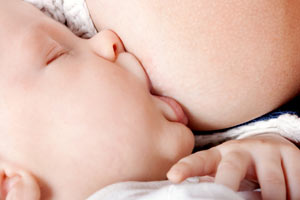
As a new mom four years ago, I knew I wanted to breastfeed my son from early on in my pregnancy. I took a class, read the books and figured that when the time came, it would happen naturally. Sometimes that just isn’t the case. Bruised skin, nipple shields, lactation consultant visits—yes, we had our share of challenges. But in the end, my oldest son nursed for 14 months, as did my youngest son, who is now nearly 2 years old, and I wouldn’t trade those cherished moments for anything. Sure, we had some bumps along the way, but we made it work. And so can you.
There is nothing more precious and awe-inspiring than holding your brand-new baby in your arms. Talk about putting life into perspective. This tiny being that depends on you for everything is the epitome of unconditional love. Perfectly swaddled, he lies sleepily in your arms, exhausted from his recent journey into the world. Then, he wakes up. And he’s hungry. Instinctively, a baby wants to nurse. Sometimes he needs a little guidance, though, as does mom.
“Breastfeeding is a learned art for all parties involved,” says Leah Ehrlich of La Leche League of Marion County. “Educating yourself before your baby arrives is the best advice we can give to any expectant mom. It’s necessary to have a support system to turn to as well when questions arise.”
So why breastfeed? The better question would be, “Why not breastfeed?” The health benefits for both mom and baby are plentiful, and the bonding experience is unrivaled.
“There’s significant research that shows a decreased risk in all types of cancers for moms who breastfeed,” says Dr. Jimi Francis, who earned her doctorate in maternal/infant nutrition and has been an international board certified lactation consultant (IBCLC) for 20 years. “Of course we’re talking about breast, cervical and ovarian cancers, but risk for other cancers is lessened as well.
And, the longer you breastfeed, the longer the benefits will last. As a matter of fact, Dr. Francis says it takes your body a year or two after weaning to return to its pre-pregnancy chemical state.
In addition to the cancer-fighting qualities of nursing, mom releases the “mothering hormone,” prolactin, during nursing sessions.
“This feel-good hormone is a cross between an opiate and an endorphin,” says Dr. Francis. “It really helps mom and baby bond and enjoy breastfeeding.”
And we’ve all heard that nursing your baby can help you lose the baby weight at a faster pace.
“It takes a lot of energy to make milk,” says Dr. Francis. “To put it into perspective, moms burn about 300 calories a day while maintaining a pregnancy. To nurse, we go through 800 to 1,000 calories a day, 500 of those coming directly from fat stores.”
If you do the math, that means nursing moms have the potential to drop about a pound a week after baby’s birth. At that rate, you’d be back in your skinny jeans in no time!
And let’s not forget the baby.
“Babies who nurse exclusively definitely have a stronger immune system, says Renee Cuppy, registered nurse and IBCLC at Munroe Regional Medical Center. “Breast milk is packed full of antibodies. Sure, breastfed babies can still get illnesses, but they tend to be less severe and have a shorter duration.
“Babies who breastfeed also tend to have less tummy issues since breast milk is so easily digested, “Cuppy adds. “Plus, breast milk is always available, always at the perfect temperature and always ready to go.”
So now that you’ve decided to breastfeed. How do you get started?
“The labor room is really the best time to introduce the baby to the breast,” says Cuppy. “Immediately following birth, your baby is most alert and ready to go. After about one or two hours, they begin to fall into a sleepy recovery stage and it can become a bit harder to get them to nurse.”

And Cuppy stresses to let your doctors and nurses know your plan to breastfeed so baby isn’t inadvertently given a bottle of formula. The same holds true if you have a cesarean delivery.
“Communicate with your health care team,” she says. “If we know up front what you want, we’ll do everything to follow your plan.”
Cuppy adds that new moms at MRMC have a high breastfeeding initiation rate—in the mid 70s.
“Moms want to nurse their babies and start the process, but we find that as time goes by, they lose their support system and quit earlier than they originally planned,” she says. “A mom, no matter what stage of breastfeeding she’s in, from day one to the weaning process, should always seek help from a professional when it’s needed. The services are free.”
Talk to any breastfeeding expert and they’ll all agree that the No. 1 factor in ensuring successful breastfeeding is a proper latch.
“You can make all the milk in the world, but if baby can’t successfully transfer it, then it doesn’t do any good,” says Cuppy.
First and foremost, it shouldn’t hurt. Sure, the initial few latches might make your toes curl and feel uncomfortable for a minute or two, but beyond that, it should be pain-free. In the early stages, you’ll even feel some tightness in your tummy once baby begins to nurse.
“There will be plenty of uterine cramping the first few days following the birth,” says Dr. Francis. “The oxytocin being released while breastfeeding causes the smooth muscles of the uterus to contract, allowing it to expel blood and shrink back to its original size, preventing excessive bleeding or hemorrhaging.”
“I always tell moms, if you have to use your Lamaze breathing, then you should call someone for help,” smiles Ehrlich.
“Having a correct latch allows for greater suction on the breast and prevents baby from swallowing air,” agrees Cuppy. “If the baby can efficiently empty the breast, then the supply-and-demand aspect of breastfeeding is much easier to establish.”
So what accounts for a satisfied baby? It may be hard to tell when your baby is getting enough milk, especially in the early weeks when you’re still learning to navigate your way around one another.
“Crying isn’t an indication of not getting enough milk,” says Amy Reynolds, a certified midwife and La Leche League leader. “Don’t worry about input as long as you have output from your baby. You should be getting about six to eight wet diapers and two bowel movements a day, plus you should be able to see milk around baby’s mouth and hear him swallowing during a feeding.”
During the first few days of nursing, baby will receive colostrum until mom’s milk comes in, which normally occurs around the third day or so following birth. This “yellow gold,” as some call it, comes in very small quantities, but it packs a serious nutritional wallop. Chock full of antibodies, colostrum passes precious immunities to your newborn, not to mention all the vitamins and minerals he needs. It’s normal for a baby to lose as much as 10 percent of his body weight in the initial days of life, but by 2 weeks old, however, most babies have returned to their birth weight.
“As the baby reaches a variety of growth spurts, including around 10 days, three and six weeks, and three and six months, his tummy will begin to stretch to accommodate more milk,” says Cuppy.
During these times, your little one may seem fussier than normal and act unsatisfied after a nursing session. As your body makes note of this, the supply will increase to meet your baby’s demand.
As you make it past the initial hurdles of breastfeeding, and things are (hopefully) going smoothly, the next big challenge is to stick it out. Remember, it’s recommended that babies breastfeed exclusively for the first six months of life, followed by at least a year or two of nursing after that.
If you’re a mom who will be returning to work, making breastfeeding last can prove to be a challenge. There’s the pumping, storing and getting baby to accept a bottle issues. I’m proof that it can be done, though. Yes, I know, most of us would rather stay home with our bundle of joy, but the mortgage won’t pay itself, right? First things first, let’s talk pumps.
Manual, electric, double electric. Who knew there was such a variety when it comes to breast pumps? If you’re a working mom, Cuppy recommends a hospital-grade double electric.
“You’ll get the job done in half the amount of time,” says Cuppy. “And if you’re going to be introducing a bottle for expressed milk, the best time to do that is around 4 weeks old.
“You certainly want to try baby with the bottle a few times,” adds Cuppy, “because you don’t want to get stuck with an emergency if baby won’t accept the bottle. Waiting until you’ve already gone back to work is too late to introduce the bottle.”
Sometimes it takes trying several brands before finding one that your baby is comfortable with. After you return to work, you will certainly learn the finer points of pumping at the office… or in the ladies room, or in the car. Whatever the case may be, moms who are exclusively breastfeeding will normally need about three 10-to-15-minute pumping sessions per work day. Pumping can be a bit overwhelming for some, but look at it as an opportunity during your day to think about your baby.
As baby begins to eat solids, usually around six months, those sessions will most likely begin to decrease.
And if you’re trying to build up your freezer stash and your little one is sleeping through the night (hallelujah!), set your alarm for the middle of the night or very early in the morning for an added pumping session, as this is when your prolactin levels are at their highest.
“Another great way to increase your supply is to nurse on one side and pump on the other once nursing is established,” says Reynolds.
In the end, it doesn’t matter how you achieve your breastfeeding goals. The ultimate goal is the same for everyone: to nourish your baby the best way you know how. Whether it’s six months or two years, the benefits to your baby—and yourself—are overwhelming.
The topic of breastfeeding is a vast one—one that’s covered in countless books and countless more websites and discussion boards. From pregnancy to the weaning process, nursing moms need to know that support and guidance is available. Although breastfeeding rates aren’t where pediatric and lactation specialists want them to be, they are certainly on the rise.
“The U.S. had a breastfeeding rate of about 20 percent in the 1970s,” says Dr. Francis. “According to the latest numbers by the CDC, the number of mothers initiating breastfeeding with their newborns is closer to 75 percent.
“What we have to work on as a nation is the duration,” she adds. “Breastfeeding is natural, yes, but it’s a learned behavior. We need to talk about it, see it, teach it and learn about it. In the end, it’s about figuring out how to make this dance work between you and your baby.”
The Lowdown On The Latch

Forget location, location, location. It’s all about latch, latch, latch. Follow these suggestions to help your baby achieve a successful breastfeeding latch, courtesy of Leah Ehrlich of La Leche League of Marion County.
Hold baby snuggled very close to your body, tummy-to-tummy.
Begin with the nipple pointing at baby’s nose.
As the breast touches baby’s chin, wait for baby to open really wide.
As baby opens wide, roll the breast into the baby’s mouth and onto the tongue, with the lower jaw as far back on the breast as possible, away from the nipple.
After the baby’s upper lip covers the nipple, snuggle thebaby’s body in closer to yours. The whole front of baby’s body should be in contact with your body, with baby’s legs wrapped around your side.
Need Help?
La Leche League of Marion County
Meets the first Saturday of each month at the Ocala Public Library headquarters at 11am
(352) 369-8328 / (352) 629-1945
Munroe Regional Medical Center, Breastfeeding Support
(352) 671-2164 (daytime)
To register for prenatal breastfeeding classes at MRMC, call (352) 368-3474.
Breastfeeding: The Benefits
For Baby
Reduces risk of middle ear infection, gastroenteritis, respiratory illness, SIDS, necrotizing enterocolitis, obesity and hypertension
Reduces risk of diarrheal illness among breastfed infants by half
Reduces risk of any middle ear infection by 19 percent and 80 percent with prolonged episodes (> 10 days)
Reduces the odds ratio for obesity at school age by about 20 percent
For Mommy
Reduces risk of breast, ovarian and endometrial cancers, type 2 diabetes and incidences of postpartum depression
Promotes weight loss
Promotes small declines in overall cholesterol levels
Source: American Dietetic Association
WHO’S Breastfeeding in Florida?
Day 1:75.7%
4 months: 30.7%
6 months: 11.9%
The kicker? The World Health Organization recommends exclusive nursing for the first six months of life and to at least 2 years of age or longer if desired. The American Academy of Pediatrics also recommends breastfeeding exclusivity for the first six months and continued nursing for at least the first year.
Sources: World Health Organization, American Academy of Pediatrics






